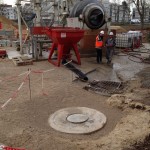The kaizen way to environmental performance
Reduce your carbon impact by half. In the worst market conditions in living memory. Without investment.
This is what this mid-sized construction company has done, cutting its carbon footprint by 47% in four years whilst fighting for survival in a sector shrinking every year since 2008 and in the grips of a deadly price war between huge corporate competitors.
Environmental performance is a difficult challenge to grasp because it seldom can be tackled by a single tech-driven breakthrough. Overall environmental performance is the result of hundreds of processes in the company. How did this company do it?
- Practice kaizen relentlessly: for the past 9 years, the CEO of the company has been a lean adept and has taught every project group in the company how to practice kaizen to earn customer smiles whilst reducing waste – not just environmental waste, but all forms of waste.
- Face the environmental issue and measure the carbon impact: the CEO has also decided to face the problem and commissioned a specialist firm to rigorously measure the carbon impact of the firm as a whole, process by process.
- Explore and discover targeted opportunities: out of the many kaizen projects, a few showed real promise in terms of environmental performance and were spread across the projects.

For instance, here the water coming out of the concrete mixer is captured in a simple well with a filter, and the clean water runoff ends up in the second tank from which it is reused in the mixer.
The spectacular improvements in environmental performance are the outcome of many such kaizen initiatives and insights.
Overall, the outcome is improvement without investment and, just as important, a much deeper understanding of the environmental impact of the construction process, leading to further improvement ideas as the technical stories evolve and people see what is possible and dream up what could be possible next.
Small step kaizen can lead to large-scale results with complex problems by facing our problems, trying practical ideas immediately, thinking deeply about impact and then asking: what next? With complex embedded problems such as environmental performance, 100 times 1% gains gets you there faster than 1 time 100%.
One Comment










Pingback: The kaizen way to environmental performance - L...